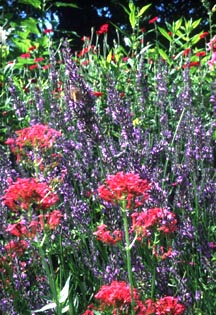 Last winter I taught a class in perennial garden maintenance. A middle-aged man raised his hand and laughingly asked what I meant when I spoke about “deadheading.” He said “The term ‘Deadhead’ makes me think of Jerry Garcia’s band, the Grateful Dead; it reminds me of tie-dye attired groupies who followed the band from concert to concert.”
Last winter I taught a class in perennial garden maintenance. A middle-aged man raised his hand and laughingly asked what I meant when I spoke about “deadheading.” He said “The term ‘Deadhead’ makes me think of Jerry Garcia’s band, the Grateful Dead; it reminds me of tie-dye attired groupies who followed the band from concert to concert.”
For some people, I guess, it’ll always be about rock and roll; but for gardeners, deadheading is a routine part of perennial bed maintenance. In the garden, deadheading means cutting off the wilted or spent flowers. This is done to approve the appearance of plants. It also prevents the seeding of many small plants you will have to weed out later. Sometimes prompt deadheading stimulates a second flowering.
How a plant is deadheaded depends on how its flowers are formed. If the flowers are at the end of a long bare stalk, the entire stalk can be cut off near the ground. Snipping the flowers off of the top would leave straight, bare stems that would be rather unsightly. Hostas, Lady’s Mantle, and Coral Bells, are examples of perennials whose flower stalks get cut close to the ground.
Perennials that have leaves on their stems will often produce more blossoms when deadheaded. New flower stalks may grow from the leaf-nodes, which is the area where a leaf meets the stem. So make the cut just above the leaves growing below the wilted blossoms. Plants that produce new flowers when deadheaded this way include Salvia, Spiderwort, and Garden Phlox.
For gardeners who want their perennial beds to be as low-maintenance as possible, there are plants that don’t need deadheading at all. Astilbe, Russian Sage, and Sedum ‘Autumn Joy’ are just a few of these.
When in doubt about how a perennial should be deadheaded, you can usually cut the flower stalk down to the base of the plant. Only woody plants such as Lavender and Santolina would be harmed by this approach. All other perennials will be more attractive for your efforts.
